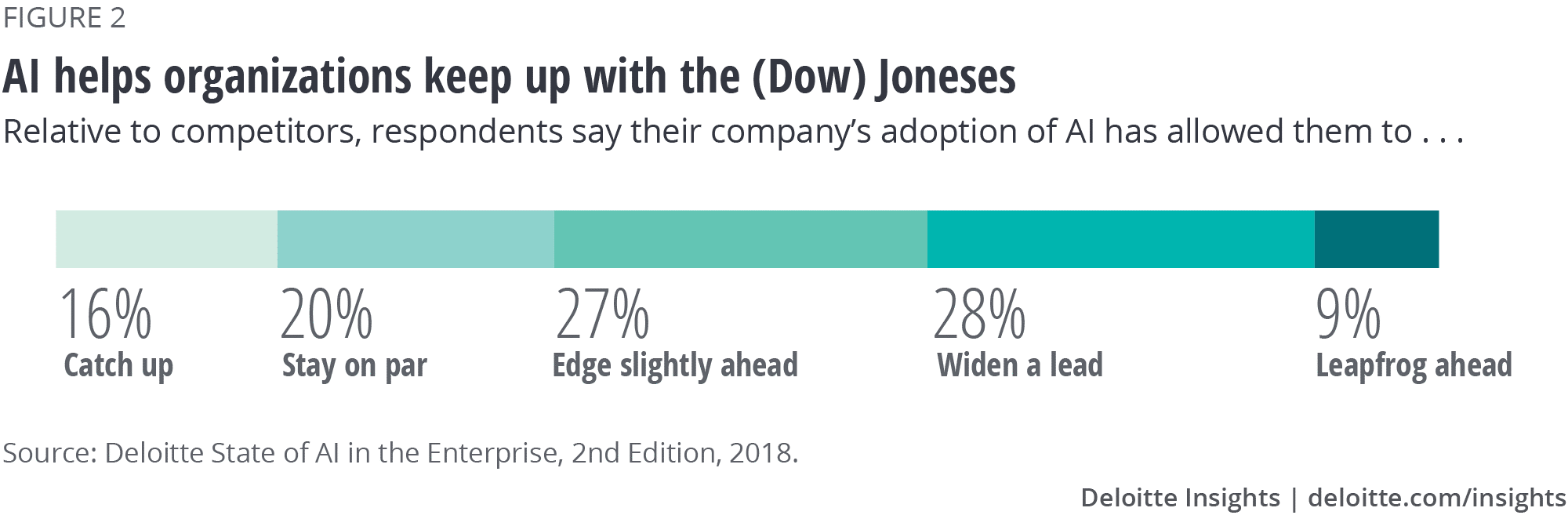Industry leaders across different verticals are setting examples of how cognitive technologies can be adopted to digitally transform a business. Many of these early adopters are betting on artificial intelligence to gain a competitive edge.
According to Deloitte, 63% of businesses believe expect their AI initiatives to help them catch up with their competitors in the industry, convert their leads, and help them stay on top of their game.

Looking at these numbers, it can be stated that the connection between adopting AI and gaining a competitive advantage is strong.
Artificial intelligence can be broadly defined as the ability of a machine to work in a way a human brain works by developing perceiving, learning, reasoning, and problem-solving capabilities. These abilities can be leveraged by organizations to address business challenges.
Deploying artificial intelligence clearly brings some noticeable benefits for enterprises; however, the journey to deployment is often accompanied by a number of challenges. Before diving into the roadblocks in AI adoption, let’s have a look at what a business requires for AI implementation:
- A large number of individuals who are willing to provide you with their data.
- A technology or device through which the data can be captured from people. This can be done in several different ways; for instance, through a form on a website, through voice commands given to voice assistants, through applications that collect data from mobile devices, or even through robots that glean data from users.
- A database to store all the raw data that is collected.
- Algorithms to organize the data for exploratory analysis.
- A clear definition of the problem in a quantitative form.
- An effective algorithm that is trained on a large dataset.
- Structured responses delivered as feedback to the designated users.
- Lastly, a pipeline to reach the end users, who will ultimately utilize the insights to their benefit.
A number of challenges crop up when a business plans to adapt AI. Some of the most common obstacles that your organization is likely encounter include:
1. Technology challenges
Data issues
The foremost roadblock in the journey of AI implementation is the lack of relevant and insightful data that is unbiased and does not compromise user privacy. The availability of a large value of data does not guarantee the availability of data that is actually useful.
According to a McKinsey survey, out of 100 organizations that have piloted AI in at least one of their functions, 24 stated that the biggest barrier in AI implementation is the lack of usable and relevant data.
One might think that companies are continuously collecting data, which should be sufficient to feed into the AI system. However, just collecting data is not the solution here, they need to collect the right kind of data. So, instead of starting with the segment for which they have the most data, they should start with the section where they can find the most valuable data.
Cost of tools and development
When planning to develop AI systems from scratch, the cost associated with human resources and technology can be quite high. This cost will be on the higher side for companies that are just starting out and do not have employees with the right set of technical skills.
A majority of smaller organizations with lower budgets and lack of experience outsource their AI development to IT companies that possess the required skills and experience.
A better alternative is to leverage tools that are developed to work with systems that companies from a particular industry sector are already using.
RELATED BLOG
According to Deloitte, 59% of organizations are meeting their AI needs by adopting enterprise software with AI. For instance, Salesforce Einstein is a tool that comes with built-in AI that helps sales representatives to identify which leads are more likely to convert to sales.
2. People & cultural challenges
Unclear leadership
When it comes to larger organizations embarking on the journey of AI implementation, there is no lack of leaders ready to involve themselves in the project. In fact, there are too many leaders with too many opinions, which often turns into a bigger problem than a lack of leadership. All of these leaders have overlapping responsibilities and areas of work, which means that there is often no single owner of the enterprise AI projects.
Many enterprises, or rather teams from these enterprises, are thinking about investing in emerging AI technologies; however, they often fail because the whole organization does not share the same vision. For instance, one team or department may be too quick and enthusiastic in adopting upcoming technologies, while the organization’s IT division is too slow to cope up with the pace of change.
This can lead to uneven adoption of technologies, which can drive up the costs over time and may conflict with an overall AI adoption strategy. The only way out of this challenge is by taking ownership of the AI systems and projects across the enterprise, and this should be done by someone in the c-suite.
3. Process challenges
Another major hurdle in AI adoption is how AI will change the existing business processes and structure. Every member of an organization has a different point of view about AI and its potential in terms of things that AI can and cannot do for an enterprise. The fear of letting in an AI system that will disrupt the existing cohesive structure of the business often stops employees from placing their trust and putting their efforts in AI projects.
Including AI as a part of the systems that companies are already using – such as CRM or ERP – is one be an effective way of integrating AI into business processes without provoking too much opposition from the users.
4. Implementation challenges
Skills shortage
Even after organizations decide to move ahead with AI implementation, most of them do not have the required skills to develop AI systems. According to a Deloitte survey, 31% of organizations see skills gap as one of their top three challenges in AI adoption.
The problem here is, most of the companies cannot do it on their own due to the lack of required skills. Some skills are more in demand than others, but one thing that is certain is – AI implementation requires a broad set of skills.

The only way to create AI systems when companies are running short on the skills is by outsourcing the development of AI-enabled systems that can be easily integrated with the company’s existing tools.
Looking further
Despite all the roadblocks, AI adoption is inescapable, at least for the businesses that wish to stay relevant. Some of these roadblocks may slow down the AI advancements, especially due to lack of skills or AI ownership.
However, there is no doubt that the time is ripe for business to benefit from human characteristics such as the ability to analyze and the ability to adapt. The only difference is, we need to teach them to intelligent machines, rather than doing all of it ourselves. If your business also wishes to make the most out of AI, let’s team up.













